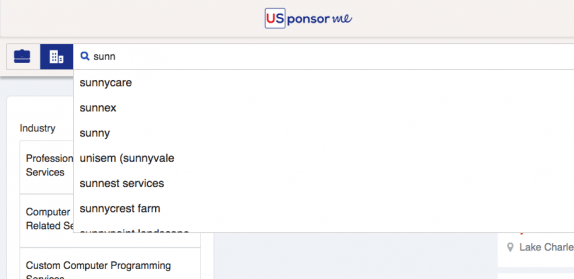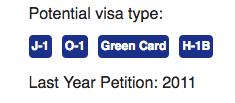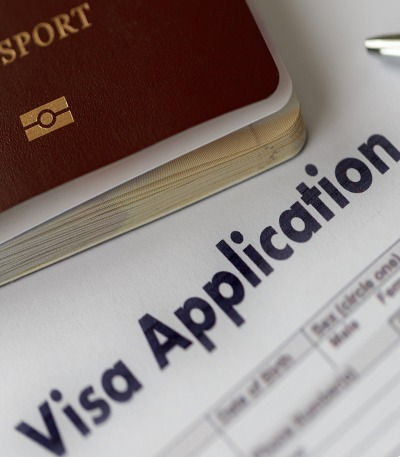Once you have your American resume in hand, you are ready to dive into your job search to live in the US.
There are 3 strategies for finding a job in the United States:
- applying for job openings (by applying online or by email directly to the internal recruiters if applying online is not recommended),
- sending unsolicited applications (if no open job),
- or through an internal referral – with our without open job (by using your own network, or by getting an internal referral without network).
In this article, we will see in detail the third strategy by activating your own network. Whether or not you already have a good network established in the United States, I will share some tricks to activate your network the right way in order to obtain the job of your dreams.
If you have never had any work experience in the U.S., you might think you have no contact in this new country. Before making hasty conclusions, read this article to the end, apply my tips and build your chart. Only at the end will you be able to conclude whether or not you really have a network in the USA. Share your experience in the comments and tell us if you’ve found contacts in the U.S. or not!
Networking: does this strategy work in the United States?
When we know that a significant number of open jobs (80%, according to the Wall Street Journal) are never published, we can conclude that networking is vital in the U.S. Believe me, I’ve lived there for almost 5 years so far, and I confirm that networking is essential here.
Americans will always prefer a person who has been recommended, even internally! For example, when Max was not available to do a project at his job, his American colleagues, instead of referring to their hierarchical manager (who is not necessarily present in the structure of the company) asked Max if he knew anyone inside the company to replace him.
It’s the same with recruitment. The hiring manager (the person who needs a specific skill set on his team) will always start by searching his own contacts before connecting with human resources. We are beginning to understand how things work in our dear host country. 🙂
Making a good first impression: an essential strategy in the U.S.
So, now you understand that activating your network can greatly increase your chances of landing the job you are targeting.
Many of my followers got interviews and even found their job through their network. Max has also landed his first job interview in the USA, in Denver, because he has been recommended by his former boss.
Use your current contacts
Activate your network; start by using the contacts you already have. Think of the many people you know; it could be family, former and current classmates, teachers, managers, colleagues, clients, suppliers, and partners, and even the people you met at events, on the street, etc. Everyone you know potentially has something to offer.
Among them, you will certainly find individuals involved in your field of activity, and possibly even some in the United States.
Where to find your current contacts?
Your current contacts can be found in your personal and professional mailbox and your phone, as well as on social network platforms like Facebook, LinkedIn, Instagram, Twitter, etc.
Your first mission is to list the platforms where you can import your contacts to your phone or computer, and so group all your contacts in one place.
Be careful with social media platforms, especially with LinkedIn! When I say “your network,” I mean the people you know. On LinkedIn (or other social media platforms), it’s possible that you are in contact with people you’ve never had an exchange with. I know by experience that using the network strategy with those people doesn’t work at all.
However, certain of your “ghost” LinkedIn contacts may be useful for you, not with strategy I’m currently teaching you, but with the others: applying for job openings, sending spontaneous applications, or by getting an internal referral with no network. In these cases, your approach will be completely different. We will cover this in another post.
If you have few contacts
I think the best strategy is to group your contacts in an Excel sheet. Indicate the first and last name of the person, their company, the size of the company, the title of their position, their location, the language with which you can communicate with them, your affinity with them (if you are close or if you don’t know this person well), and the platform/channel on which you are in contact with this person.
It should look like this:

If you have plenty of contacts
In this case, I advise you to use FullContact. This application allows you to group all your contacts easily and quickly by connecting the different accounts on which you have an address book (LinkedIn, Gmail, etc.). You can even submit your address book in CSV (data that you can export from your different tools).
For each person, you will know the platform/channel on which you are in contact. The tool will also automatically enhance your contacts from the internet with more info regarding their job titles, locations, company, the size of their company, their websites, if any, and links to their social media profiles.
Then you will have to use tags, and will tag the language you can use to communicate, your affinity, etc.
Again, whether you use FullContact or an Excel sheet, take into account only your real contacts: the people you’ve had an exchange with at least once, either physically, on the phone, or by email.
Once you have completed this step, all you have to do is enjoying this new playground …
Which contacts can really help you?
To activate your network, you must then define the categories of the people who can help you in your job search.
The Human Resources and Recruiters (HR)
The first category that can help you in your job search is Human Resources Specialists or Recruiters. Find all the people in your real contacts who are HR or recruiters, based in the U.S. or not.
If you use Excel, then add “HR” (Human Resources) in the “HM / LH / HR” column. If you use FullContact, add the “HR” tag to your relevant contacts.
The Hiring Manager (HM)
The second category of people who can help you in landing your dream job is the Hiring Manager, the one who needs you in the business.
Basically, ask yourself: What is the profile of my future manager? Who is the person who specifically needs me on his team? What is the job title of this person?
This will usually vary depending on the size of the business. In a large company, look for the department director, or the team manager. In a small company, it will likely be the CEO, or a C-level person.
The Little Helper (LH)
The third category of interest is the Little Helper. This is the person who will work with you–the one who will have the same position as you and at the same hierarchical level. Basically, it’s your future colleague.
The Little Helper is very important. Even they don’t have a say in your recruitment, they can recommend you to their manager.
Action!
Your third mission in order to activate your network is to define the job titles of these last 2 types of people, Little Helper and Hiring Manager. Remember, this can change depending on whether they area with a large or small company. Write down all the job titles in English and also in your own language if different.
Once you got them together in one place, find all the people in your real contacts who have those job titles. If you use Excel, then add “HM” (Hiring Manager) or “LH” (Little Helper) in the column “HM / LH / HR.” If you use FullContact, add the “HM” or “LH” tag to your relevant contacts.
If you have not identified any LH, HR, or HM in your contacts, skip to the “What to do with other contacts” section of this article.
Refine your search with Contact Based, and Company Based
Search among your HR, HM and LH contacts:
- People based in the USA (Contact Based)
- OR people’s companies with a U.S.-based structure (Company Based).
And add it to your Excel spreadsheet, or tag it in the FullContact app.
It should look like this in your table:

Prioritize which people you contact first based on these categories.
If you haven’t identified “Contact Based” or “Company Based” people among your LH, HR ou HM contacts, skip to the “What to do with other contacts” section of this article.
How do I get in touch?
Once you have identified the people who can help you with your project, get in touch with them!
The stronger the connection you have with your contact, the easier it will be for you to get in touch with them.
The goal is to start by contacting those HR, HM and LH people who are Contact Based and Company Based. Choose those with whom you have the most affinity, and send them a message using the following tips:
- Give them some news.
- Ask them what’s new.
- Introduce your project–your plan to work in the United States.
- Ask them if they have any opportunities for you in the USA.
- If not, ask them if they know people based in the USA who can help you.
Follow your intuition! If you feel it’s better to catch up on each others’ news before asking about opportunities, you can definitely write the first message with that intention. Once your contact responds, go ahead with your request! It really depends how long you’ve been in touch (or out of touch!) with your contact, and how close you are with them.
What do I do with the other contacts?
Even if your direct contact is not someone who can help you, they can potentially know someone who can.
This was the case for many of my members, including Max.
Even though he didn’t have any HR, HM or LH based in the USA or who worked in a company based in the USA, he was recommended by his former boss (where he did his internship) to a partner he had in the USA. Max then landed his first job interview with a company based in Denver.
So this time, you will try to reach your contact’s contacts–the second-level contacts. But before you do, be sure to think it through.
Is your current company also based in the United States?
In time, you will naturally delete some of the contacts from your list, simply because you do not want to share your project with them.
But if you feel like doing so, and if you get along with your current employer, share your project with him or her. If you have good relationships with your line and human resources managers, they can listen and support you as needed and can be strategic allies. You can bring the subject up during your annual interview, or request an appointment if your expatriation project is more urgent.
It is even more effective if your company already has a foot in the USA. In this case, you can even attempt a transfer request.
If this is not the case, your employer may have contacts in the United States with partners, customers or suppliers with whom they work or have worked in the past. They can also be very helpful to you.
One of my former clients found his job in the US hotel industry thanks to his boss who had recommended him to one of his partners in the United States.
Connect with your contacts
Again, connecting with one of your contacts is easier if they are close to you or happy with your work. But you can also fall on a Booster in your contacts–someone who, even if you do not know them very well, will be ready to help you.
The message template will essentially be the same:
- Give them some news.
- Ask them what’s new.
- Introduce your project.
- Ask them if they know anyone who could help you.
It is this strategy that Max used to get his first interview in the USA. 🙂
Again, 1 or 2 messages–it’s up to you.
It’s just as simple if your contacts are on LinkedIn, because you can see their contacts and find an HR, HM, or LH who could help you. But before expressly asking your contact for an introduction to this person, ask them if they know this contact personally! If not, it’s a dead end, and you should stick to the original plan. 😉
Enable second level contacts
In return, your interviewer can either give you their contact’s information, or they can introduce you to their contact (the latter is the best solution of the two).
If they give you their contact’s information, ask if they could possibly introduce you. If they refuse, ask if you can give their name as a referral when contacting the contact.
The risk of this strategy and how to avoid it
Even if this strategy is much better than the first one (aka “postulate and wait” strategy) that you had in mind (don’t deny it), it has its risk.
As a reminder, it is not possible for you to get a job in the United States unless you have a structure (your company or an organization) that sponsors you for a work visa. The visa and the job go hand in hand! However, you are not eligible for all types of visas that exist in the U.S., and not all companies are eligible to sponsor or take someone under a work visa.
As with Max during his first interview, the company may say that it cannot sponsor you for a work visa.
Something VERY important to do before even getting in touch with the company
Before you even get in touch, you have to do some research!
For what visa(s) you are qualified?
I advise you to launch the Visa Simulator right away so that you can learn about potential future visas.
Then, check if your contact’s company has already sponsored one or more of its employees in the past, the last time they did so, for what visa, and if this visa matches the one calculated for you.
Check if the company has already sponsored someone for a visa
For this, you must have a USponsorMe account so that you can get access to the full list of corporate sponsors here. Then, in the search bar at the top, type the name of the company concerned.


Then click on the company and on “More info about the company.” It will give you all the information you need. And you will see the visas for which this company has already sponsored one or more of its employees.
If the company and the visa are present
Good news! This means that the company is familiar with the process, and has already sponsored one or more employees for your visa. The company already has a lawyer (you can see this on the company page on USponsorMe) to take care of the immigration process.
You are on the right track. 🙂
If the business or the visa is not present
If you cannot find your company on the list, or if the visa for which you are eligible is not in the list of visas for which the company can potentially sponsor someone, don’t mess up!! Act VERY quickly!
This means that the company does not usually sponsor its employees for a work visa. And the big risk is that because of a lack of knowledge surrounding the process, the hiring manager very often gets scared and declines your application by telling you, “We do not sponsor visa applicants.”
Or he will tell you that he will inquire about visas, and get back to you once he has more information. If he tells you that, know that it’s already too late!
Because I know the music by heart … Your interviewer is a human-like you and me. What will happen:
- Your interviewer will contact a lambda immigration lawyer. Keep in mind there are about 185 existing visas! Even a good immigration lawyer is not an expert on all visas–it’s NOT possible! Usually, an immigration lawyer will be an expert on up to 10 kinds of visas, max. So what’s the chance you end up with a good lawyer who’s an expert on the visa for which you are eligible? 1 in 20. Ouch.
- OR worse, your interviewer doesn’t, so they will do some research online, and automatically fall upon the most popular type of visa: H-1B or H-2B. He will read everywhere that this visa is almost impossible to get (which is true in general, though there are exceptions, depending on what visa the Visa Simulator calculates for you). Voila…
The result? He will come back to you with the most beautiful phrase of all time: “We do not sponsor visa applicants.” 🙁
That’s exactly what happened to Maxime, and that’s exactly what happens every day to candidates who don’t find me and this post before their first exchange with their company.
So…even before having your first exchange with the company, you need to have all the knowledge you can on the strengths of the visa for which you are eligible.
Because if you really want to make it work, you have to educate the company on the type of visa, the way you will get it, who will take care of the procedure and paperwork, how long it will take, etc. Your goal is to reassure the company by completely lifting the fog on this visa.
Once you have passed the Visa Simulator, you will know for which type of visa you are eligible AND you will receive all the information you need to get it!
Be careful!!! The visa that the Visa Simulator calculates for you may not fit your particular target company. So please check the information you receive once you know your visa. If the company doesn’t fit, or if you have any questions, contact us (you will need to create a USponsorMe account). We work in partnership with several immigration lawyers and can point you to the right organization or lawyer depending on your situation.
In summary
To sum up, you have to follow 4 steps:
- Gather all your contacts in one place and enrich your data.
- Define the HR, HM, and LH and those who are in contact with the United States among your contacts.
- Contact these HR, HM, and LH.
- Connect with your contacts’ contacts to reach HR, HM, and LH in the USA.
- Do your research on the company, and on your visa.
Don’t forget that in networking matters, the key is reciprocity. The day your helpful contact needs a favor in return, do it!
Once you have gone through your contacts and your second-level contacts, you can easily expand your field of action. And that’s what we’ll see in the second part of this lesson (coming soon).




